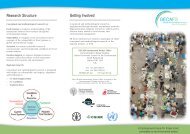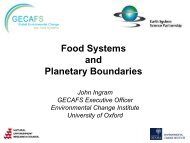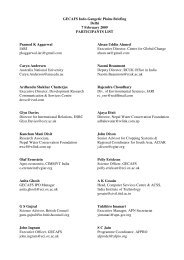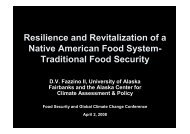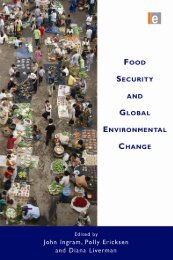interventions and political inertia in funding decisions than <strong>to</strong> technical ignorance (seequotation above). Given that food prices are again high – in March 2011, the food indexremained 36% above its level a year earlier (World Bank, 2011) – there is a strong likelihoodthat this number will again rise.This link between food prices and numbers of food-insecure people underscores theimportance of the affordability of food in relation <strong>to</strong> food security. This is reflected in thecommonly-used definition stemming from the 1996 World <strong>Food</strong> Summit (FAO, 1996b)which states that food security is met when “all people, at all times, have physical andeconomic access <strong>to</strong> sufficient, safe, and nutritious food <strong>to</strong> meet their dietary needs and foodpreferences for an active and healthy life”. This definition puts the notion of access <strong>to</strong> foodcentre stage. Further, not only does it bring in a wide range of issues related <strong>to</strong> a fullerunderstanding of food security, but some key words such as “food production” and“agriculture” – which might have been expected in such a definition – are not included; theemphasis changed from increasing food production <strong>to</strong> increasing access <strong>to</strong> food for all. Thisdefinition also integrates notions of food availability and food utilisation. Many otherdefinitions of food security exist; even by 1992 Maxwell and Smith had counted over 200(Spring, 2009) and more are still being formulated (Defra, 2006). The majority of the morerecent (i.e. since the 1990s) definitions have the notion of access <strong>to</strong> food central and are nowmanifestly very valuable in raising the profile of access <strong>to</strong> food in relation <strong>to</strong> producing food.While it is important <strong>to</strong> note that an inability <strong>to</strong> access food is the main cause of foodinsecurity in general, some parts of the world, especially sub-Saharan Africa, still facechronic hunger due <strong>to</strong> low food production. This can be due <strong>to</strong> low fertility soils, and/or lackof sufficient land. Many such areas are also anticipated <strong>to</strong> be most severely affected by globalenvironmental change (GEC), and especially climate change (Parry et al., 2005; Lobell et al.,2008). Nevertheless, this shift over recent decades <strong>to</strong>wards a more integrated food securityconcept challenges the research community <strong>to</strong> think more broadly than food productionalone. It raises questions ranging from overarching issues related from frameworks forconceptualising food security and identifying GEC-related and other key limiting fac<strong>to</strong>rswhich determine it, <strong>to</strong> more detailed issues related <strong>to</strong> specific research foci <strong>to</strong> overcome them.This paper lays out a case for a food systems framework <strong>to</strong> help address the overarchingissues and identify the limiting fac<strong>to</strong>rs and how they interact. It also provides a number ofexamples of how selected elements of the framework can help define varied aspects of foodsecurity research <strong>to</strong> address these limiting fac<strong>to</strong>rs.<strong>Food</strong> security research approachesIn addition <strong>to</strong> highlighting the importance of access <strong>to</strong> food, the more holistic concept thatrecent definitions of food security embody identify a wide range of research challengesspanning the humanities and social and economic sciences, rather than just biophysicalsciences (Pálsson et al., 2011). There is however still a predominant research emphasis on36
increasing crop productivity, i.e. yield (biomass/unit area); a search on Google Scholar on 1stJune 2011 for articles published between 2005 and 2011 with the words “crop yield” or“access <strong>to</strong> food” / “food access” in the title identified 1360 and 230 references, respectively.Given the need <strong>to</strong> produce more food this is of course very important, but it is also driven bythe momentum of research in this area. As most of our food comes from crops, research hashis<strong>to</strong>rically concentrated on agronomy (usually focussed on the experimental plot or fieldlevel, and usually for a single cropping season) and its associated sciences, although lives<strong>to</strong>ckand fisheries also received considerable attention. This research has been vitally importantand has delivered a wide array of technological productivity advances; average yields of theworld’s main grains (wheat, barley, maize, rice and oats) have increased three-fold since1960, although increases for coarse grains (millet, sorghum) and root crops (cassava andpota<strong>to</strong>) have been nearer level (FAO, 2009b). When adopted over a large area thesetechnological advances have led <strong>to</strong> greatly enhanced production.These advances have not been without significant environmental cost, and there is now astrong drive <strong>to</strong> reduce negative externalities such as soil degradation, water pollution, loss ofbiodiversity and greenhouse gas emissions. Nonetheless, and driven by recently increasingconcerns about population growth and rising incomes leading <strong>to</strong> changing diets, the mainmotive for most agricultural research remains the need <strong>to</strong> yet further increase foodproduction. However, and as pointed out above, the fact that so many people are still facingfood insecurity despite global production currently being sufficient for all, indicates thatresearch which considers multiple aspects of food security and food systems is needed. Howcan the research ‘powerhouse’ be better geared <strong>to</strong>wards the needs of the upcoming decades,especially given anticipated changes in climate and other environmental and socioeconomicfac<strong>to</strong>rs?Agronomic research is undoubtedly still vitally important, and the author and colleaguesoutlined three major challenges for agronomists in the climate/food security debate: (i) <strong>to</strong>understand better how climate change will affect cropping systems (i.e. the arrangement inwhich various crops are grown <strong>to</strong>gether in the same field, as opposed <strong>to</strong> crop productivity);(ii) <strong>to</strong> assess technical and policy options for reducing the deleterious impacts of climatechange on cropping systems while minimizing further environmental degradation; and (iii) <strong>to</strong>understand how best <strong>to</strong> address the information needs of policy-makers and report andcommunicate agronomic research results in a manner that will assist the development of foodsystems adapted <strong>to</strong> climate change (Ingram et al., 2008). In addition, <strong>to</strong> contributing moreeffectively <strong>to</strong> the food security/environmental change debate, the agricultural researchcommunity should more actively consider how <strong>to</strong> translate findings at plot-level over a fewseasons <strong>to</strong> larger spatial and temporal levels and thence <strong>to</strong> the issues of food security.Methods for estimating regional production – and especially how it will change in future –are still relatively weak, with analyses mainly relying on statistical approaches orextrapolation from mechanistic point models, although mechanistic modelling approachesalso exist (e.g. Parry et al., 2005; Challinor et al., 2007).37
- Page 1 and 2: From Food Production to Food Securi
- Page 3 and 4: From Food Production to Food Securi
- Page 5 and 6: Table of ContentsAbstract .........
- Page 7 and 8: Paper 6: Undertaking Research at th
- Page 9: AbstractFood security is a conditio
- Page 12 and 13: 2010 about 925 million people had t
- Page 14 and 15: water) are used, and reduce negativ
- Page 16 and 17: While the flow of the argument abou
- Page 18 and 19: determine interactions along and be
- Page 20 and 21: Paper 3: A Food Systems Approach to
- Page 23: From Food Production to Food Securi
- Page 26 and 27: concerns and are now issues that mu
- Page 28 and 29: the relationships between GEC and f
- Page 30 and 31: Theme 2 aims to understand how comm
- Page 32 and 33: GEC and the Food System of the Indo
- Page 34 and 35: Paper 2: The role of agronomic rese
- Page 36 and 37: These advances have resulted from a
- Page 38 and 39: Crop selection to determine mechani
- Page 40 and 41: Agronomic science is central to imp
- Page 42 and 43: Agronomic research in relation to f
- Page 44 and 45: The discussion above identifies a n
- Page 48 and 49: While research on producing food ha
- Page 50 and 51: Box 1 Food system Activities and fo
- Page 52 and 53: In addition to broadening the debat
- Page 54 and 55: options. Examples already seen rang
- Page 56 and 57: Figure 3 Outcomes for 10 variables
- Page 58 and 59: Figure 4 Nine ‘planetary boundari
- Page 60 and 61: Figure 5 Environmental change, food
- Page 62 and 63: Table 1: Indicative analysis of the
- Page 65: From Food Production to Food Securi
- Page 68 and 69: Trade Agreement (NAFTA) and the Eur
- Page 70 and 71: Parry et al., 2005). Conducting foo
- Page 72 and 73: is provided in the ESF/COST Forward
- Page 74 and 75: Paper 5: Engaging Stakeholders at t
- Page 76 and 77: into actions (strategies, policies,
- Page 78 and 79: Box 2 Engaging with stakeholders in
- Page 80 and 81: Box 3 Setting the research agenda f
- Page 82 and 83: Third, and of considerable practica
- Page 84 and 85: Figure 2: Organizing and understand
- Page 86 and 87: organizations made up of numerous n
- Page 88 and 89: Elements of good practice in stakeh
- Page 90 and 91: Finally, it is worth noting that fo
- Page 92 and 93: development (Lee, 1999; Gunderson a
- Page 94 and 95: Box 7 The GECAFS stakeholder survey
- Page 96 and 97:
‘break down’ what might be a hi
- Page 98 and 99:
Paper 6: Undertaking Research at th
- Page 100 and 101:
agriculture in many parts of the wo
- Page 102 and 103:
gaps. The presence of a strong tech
- Page 104 and 105:
an average of two years to coalesce
- Page 106 and 107:
Institute for Meteorology and Hydro
- Page 108 and 109:
Identifying case study sitesResearc
- Page 110 and 111:
can both benefit from and contribut
- Page 112 and 113:
Box 5 Mapping stakeholder interests
- Page 114 and 115:
Holding planning meetings in locati
- Page 116 and 117:
This reorientation of the debate fr
- Page 118 and 119:
Importance of this type of research
- Page 120 and 121:
Integrating the food system concept
- Page 122 and 123:
awareness of the GEC issues within
- Page 124 and 125:
pollutants were then introduced as
- Page 126 and 127:
communities operating in food syste
- Page 128 and 129:
Improving input-use efficiency acro
- Page 130 and 131:
governance focuses on the range of
- Page 132 and 133:
Developing research agendas in supp
- Page 134 and 135:
The renewed approach to interdiscip
- Page 136 and 137:
BIELAK, A., HOLMES, J., SAVGÅRD, J
- Page 138 and 139:
EAKIN, H. 2010. What is Vulnerable?
- Page 140 and 141:
GODFRAY, H. C. J., BEDDINGTON, J. R
- Page 142 and 143:
INGRAM, J. S. I. & FERNANDES, E. C.
- Page 144 and 145:
LYUTSE, S. 2010. The One Billion To
- Page 146 and 147:
RAYNER, S. & MALONE, E. L. 1998. Hu
- Page 148 and 149:
UNDP 2006. The 2006 Human Developme
- Page 150 and 151:
activities “from plough to plate
- Page 152 and 153:
contribution to the science agenda:
- Page 154 and 155:
urgently needed, and - given the gr
- Page 156 and 157:
GECAFS plannenmakerij stelde vast d
- Page 158 and 159:
ieder hun eigen groep van betrokken
- Page 160 and 161:
het gebied van beheer hebben betrek
- Page 162:
Curriculum VitaeFollowing a BSc in



